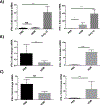House dust mite exposure attenuates influenza A infection in a mouse model of pulmonary allergic inflammation
- PMID: 30776411
- PMCID: PMC7336117
- DOI: 10.1016/j.micpath.2019.02.019
House dust mite exposure attenuates influenza A infection in a mouse model of pulmonary allergic inflammation
Abstract
Environmental allergens elicit complex immune responses in the lungs that can promote the development of asthma or exacerbate preexisting asthma in susceptible individuals. House dust mites are one of the most common indoor allergens and are a significant driver of allergic disease. Respiratory infections are known factors in acute exacerbations of asthma but the impact of allergen on the pathogen is not well understood. We investigated the pathogenesis of influenza A infection following exposure to house dust mites. Mice exposed to house dust mites lose less weight following infection and had more transcription of interferon-lambda than controls. These data correlated with less transcription of the influenza polymerase acidic gene suggesting diminished viral replication in house dust mite exposed mice. Altogether, these data suggest that exposure to environmental allergens can influence the pathogenesis of influenza infection.
Keywords: Allergy; Asthma; House dust mite; Inflammation; Influenza.
Copyright © 2019 Elsevier Ltd. All rights reserved.
Figures










Similar articles
-
Shifting of immune responsiveness to house dust mite by influenza A infection: genomic insights.J Immunol. 2012 Jan 15;188(2):832-43. doi: 10.4049/jimmunol.1102349. Epub 2011 Dec 14. J Immunol. 2012. PMID: 22174454
-
Allergy to house dust mites and asthma.P R Health Sci J. 2004 Mar;23(1):47-57. P R Health Sci J. 2004. PMID: 15125219 Review.
-
Comparison of allergen-induced late inflammatory reactions in the nose and in the skin in house dust mite-allergic patients with or without asthma.Int Arch Allergy Immunol. 2003 Apr;130(4):266-74. doi: 10.1159/000070213. Int Arch Allergy Immunol. 2003. PMID: 12740527
-
House dust mite and cockroach exposure are strong risk factors for positive allergy skin test responses in the Childhood Asthma Management Program.J Allergy Clin Immunol. 2001 Jan;107(1):48-54. doi: 10.1067/mai.2001.111146. J Allergy Clin Immunol. 2001. PMID: 11149990
-
Respiratory allergy caused by house dust mites: What do we really know?J Allergy Clin Immunol. 2015 Jul;136(1):38-48. doi: 10.1016/j.jaci.2014.10.012. Epub 2014 Nov 22. J Allergy Clin Immunol. 2015. PMID: 25457152 Review.
Cited by
-
Influenza virus-flow from insects to humans as causative for influenza seasonality.Biol Direct. 2020 Oct 9;15(1):17. doi: 10.1186/s13062-020-00272-5. Biol Direct. 2020. PMID: 33036642 Free PMC article.
-
Respiratory tract infections in children with allergic asthma on allergen immunotherapy during influenza season.Sci Rep. 2021 Jan 22;11(1):2083. doi: 10.1038/s41598-021-81558-0. Sci Rep. 2021. PMID: 33483566 Free PMC article.
References
-
- Akinbami LJ, Moorman JE, Bailey C, Zahran HS, King M, Johnson CA, et al. Trends in asthma prevalence, health care use, and mortality in the United States, 2001–2010. NCHS data brief. 2012;(94):1–8. . - PubMed
MeSH terms
Substances
Grants and funding
LinkOut - more resources
Full Text Sources
Medical

